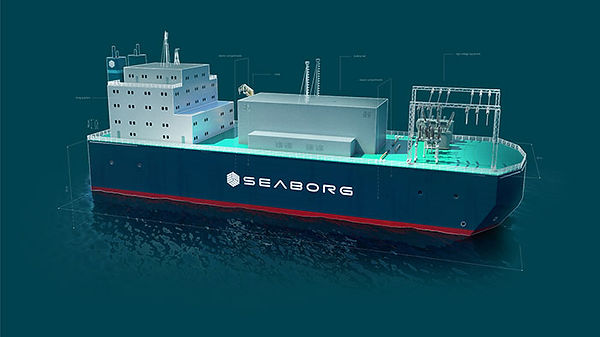RETHINKING NUCLEAR
Seaborg is developing a nuclear power plant concept fundamentally different from what exists today.

See the Seaborg Power Barge in action.
Latest news
Call for co-development partners
Interested in co-developing energy projects with Seaborg?

We are making nuclear an inexpensive, sustainable and safe technology that can out-compete fossil fuels and revolutionise energy markets.
The CMSR
Next-generation nuclear reactor

Our Compact Molten Salt Reactor, the CMSR, is safe, significantly smaller, better for the environment, and inexpensive even compared to fossil fuels.

By rethinking nuclear, we are working towards a future of abundant, affordable, low-emission energy available to all.

The Power Barge
Turnkey floating
power plant
Our CMSR will be deployed on serially produced Power Barges that have an operational lifetime of 24 years .
The Power Barges are modular and can produce from 200 to 800 MW of electricity.
How is the CMSR different from conventional nuclear?
The core is key
Conventional nuclear reactors have solid fuel rods that need constant cooling, typically using water under high pressure.
In the CMSR, fuel is mixed in a liquid salt that acts as coolant. This ensures it can always be cooled and it cannot melt down or explode. It will simply shut down by itself in case of an emergency.
The importance of this is not only the safety but also a significant reduction in complexity and cost.

Molten salt
(fuel + coolant)
Molten salt
(fuel + coolant)
Drain tanks
The CMSR core
Making nuclear SUSTAINABLE
ENERGY FOR EVERYONE
Deployable everywhere and in abundance.
SMALL ENVIRONMENTAL FOOTPRINT
The lowest resource use of any energy source.
AN ENGINE FOR
THE ECONOMY
Competitive kWh price and excellent market fit.
How does nuclear compare to other energy sources?
CO2 intensity of electricity generation
820
gCO2eq/kWh
Coal
230
gCO2eq/kWh
Biomass
48
gCO2eq/kWh
Solar
12
gCO2eq/kWh
Nuclear
12
gCO2eq/kWh
Wind
Partners and collaborators









